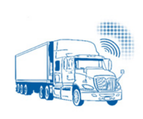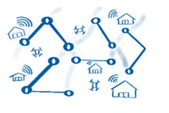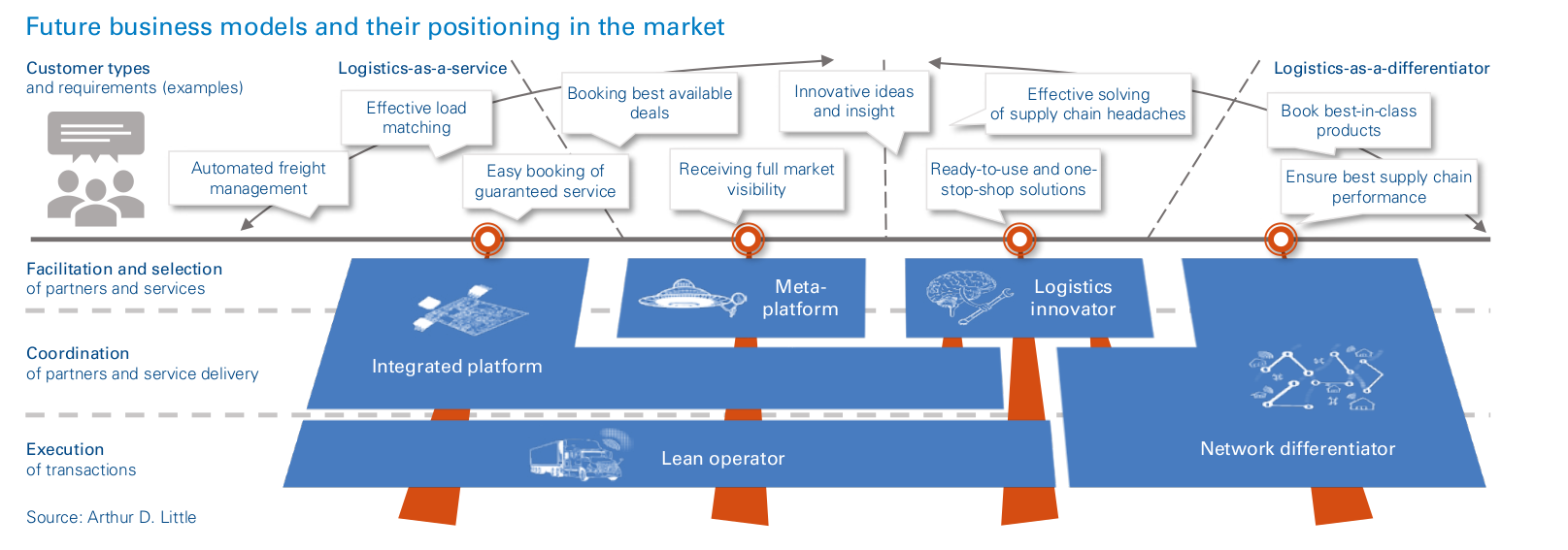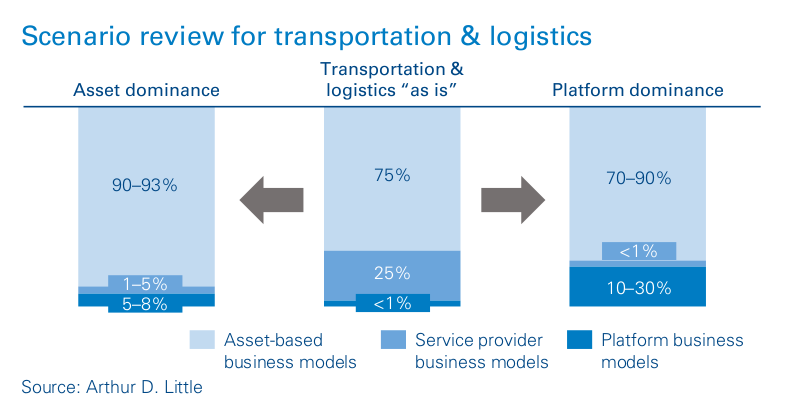
DOWNLOAD
DATE
Contact
Transformation has arrived in the transportation & logistics industry. However, we have only just witnessed the start of an extensive change process that will shake up the balance of power. Players unable to adapt to the new reality will face immense pressure, as entire business models are at stake. While the general need for transformation seems broadly accepted across the industry, an important question remains open: “Where to go with transformation?” The answer depends on the ambitions, capabilities and preconditions of the individual company, but there are some overarching principles for incumbents to consider. Are you lost in transformation? In this paper we summarize our view of the future market and outline possible paths forward for incumbents.
A vision of the future
In our vision of the 2030 transportation & logistics industry, we predict three key changes that will reshape the balance of power.
1 A rise of platforms
Platforms are here to stay – and to further evolve. Similarly to other industries, we predict digital platforms will significantly expand their role in the market. Not only will they further digitalize to become easier to use, easier to integrate and smarter, they will also continue to expand their value chain scope: towards more contract business, more direct-shipper offerings, more management of complex transport chains, and more guarantees for commercial offers and service levels. On top of this, we foresee platforms converging and consolidating towards fewer, more integrated models, which will offer various service lines based on combined user networks and offerings. Lastly, some platforms may act as meta-marketplaces by playing an aggregator role. The next-next-generation platforms will attack logistics service providers in their core business activities, taking control over the customer interface.
2 A comeback for assets
To keep or claim back some of the power they seem to have lost over the past decades, asset-based providers will relentlessly focus on establishing digitally empowered, lean processes for their business models. Minimized operating costs and optimal integrability with the outside world are key to staying competitive in an efficient commodity market. Players with the right preconditions will build superior networks with proprietary and differentiating character that cannot be easily emulated by a virtual model. This way, they can retain a grip on the customer interface – at least for certain segments of the market. Lastly, asset operators will push for further consolidation through M&A and asset acquisition to concentrate market power.
3 A squeeze on service providers
Traditional (and digital!) service provider models, such as 3PLs and LLPs, will be stuck in the middle between efficient platforms and strong network players. Depending on their situations, they may choose to push in either (or both) of the two development directions. Doing nothing is not an option. Low- and no-asset-based broker business models (i.e., pure freight forwarding) are particularly at risk because digital platforms will challenge the segment by offering guaranteed services with superior efficiency. On top of this, many of freight brokers’ traditional selling points will vanish: longstanding relationships, fixed-capacity agreements and vast logistics knowledge will lose their unique differentiation value in a transparent market.
Focusing on customer value creation through innovation, beyond the classic scope of transportation and logistics, may be the last resort for service providers that are unfit to excel in either the digital platform or the asset universe. We believe with increasing industry efficiency comes the potential for market participants to shift their attention away from tedious management of day-to-day business operations, and towards exploration of innovative solutions to address the true supply chain headaches.
Promising future business models
The new market environment will shape five promising business models, each taking over a distinct role in the market.
 Lean operator: Asset operators such as transport carriers will evolve towards more efficient digital selves. In a future, in which the customer interface (to the shipper) is mostly controlled by platform- and network-based businesses, operators must execute efficiently – and be easy to work with – if they are to access as many revenue streams as possible. Lean operators will deploy modern fleets, connect their assets, automate processes, analyze data, and establish plug-and-play integrability with the outside world to stay relevant.
Lean operator: Asset operators such as transport carriers will evolve towards more efficient digital selves. In a future, in which the customer interface (to the shipper) is mostly controlled by platform- and network-based businesses, operators must execute efficiently – and be easy to work with – if they are to access as many revenue streams as possible. Lean operators will deploy modern fleets, connect their assets, automate processes, analyze data, and establish plug-and-play integrability with the outside world to stay relevant.
 Network differentiator: Average-quality networks will no longer be able to justify significant capital costs because they will be challenged by digital business models in tomorrow’s market. Hence, companies with the right preconditions may invest in strong networks that offer built-in and proprietary advantages, which cannot be easily mimicked through a purely virtual approach. Such networks may have a global reach or be limited to certain niches (e.g., geographic). Physical (e.g., terminals and trucks) and digital elements (e.g., sensors and communication technology) may be combined in ways that will create unique and differentiating structures, which can serve as the base for superior products. Faster lead times, higher service quality, top security standards and access to scarce capacity may be some differentiating attributes. When done right, network differentiators may keep or even expand their grip on the customer interface, at least for certain segments of the market where shippers are looking to buy defined products that offer guaranteed quality which cannot be found elsewhere.
Network differentiator: Average-quality networks will no longer be able to justify significant capital costs because they will be challenged by digital business models in tomorrow’s market. Hence, companies with the right preconditions may invest in strong networks that offer built-in and proprietary advantages, which cannot be easily mimicked through a purely virtual approach. Such networks may have a global reach or be limited to certain niches (e.g., geographic). Physical (e.g., terminals and trucks) and digital elements (e.g., sensors and communication technology) may be combined in ways that will create unique and differentiating structures, which can serve as the base for superior products. Faster lead times, higher service quality, top security standards and access to scarce capacity may be some differentiating attributes. When done right, network differentiators may keep or even expand their grip on the customer interface, at least for certain segments of the market where shippers are looking to buy defined products that offer guaranteed quality which cannot be found elsewhere.
 Logistics innovator: We foresee only one service provider-like model prevailing – the logistics innovator. This business model is centered around the key objective of generating superior customer value – beyond the traditional transportation & logistics scope. By doing so, logistics innovators will conceptualize, build and implement ready-to- use, innovative customer solutions founded on individual sets of (intellectual) assets, capabilities (e.g., data analytics) and areas of expertise (e.g., logistics or finance). With this, they go far beyond the offering of today’s LLP and 4PL providers and address customer archetypes that are unable or unwilling to specify in detail the desired solution for a (unstructured) supply chain problem.
Logistics innovator: We foresee only one service provider-like model prevailing – the logistics innovator. This business model is centered around the key objective of generating superior customer value – beyond the traditional transportation & logistics scope. By doing so, logistics innovators will conceptualize, build and implement ready-to- use, innovative customer solutions founded on individual sets of (intellectual) assets, capabilities (e.g., data analytics) and areas of expertise (e.g., logistics or finance). With this, they go far beyond the offering of today’s LLP and 4PL providers and address customer archetypes that are unable or unwilling to specify in detail the desired solution for a (unstructured) supply chain problem.
 Integrated platform: The core element of integrated platforms is an efficient marketplace centered around a large user network and associated offering data pool. On this basis, platforms will offer various services to satisfy different customer segments and requirements in a “logistics-as-a-service” model, while leveraging network effects. Such platforms will offer three main service lines:
Integrated platform: The core element of integrated platforms is an efficient marketplace centered around a large user network and associated offering data pool. On this basis, platforms will offer various services to satisfy different customer segments and requirements in a “logistics-as-a-service” model, while leveraging network effects. Such platforms will offer three main service lines:
 Neutral matching services, predominantly between transport operators in a closed- market environment and based on subscription fees.
Neutral matching services, predominantly between transport operators in a closed- market environment and based on subscription fees. Guaranteed services for shippers (e.g., end-to-end spot pricing for multi-party transport chains) in an open, transaction and commission-based model.
Guaranteed services for shippers (e.g., end-to-end spot pricing for multi-party transport chains) in an open, transaction and commission-based model. Integration capability so shippers can identify, select and interface with potential partners through their own IT systems for automated management of logistics transaction portfolios in a (semi-) closed market environment, based on subscription and/or transaction fees.
Integration capability so shippers can identify, select and interface with potential partners through their own IT systems for automated management of logistics transaction portfolios in a (semi-) closed market environment, based on subscription and/or transaction fees.
 Meta-platform: Lastly, meta- marketplaces will serve as aggregators across selected logistics offerings in the digital world – wherever the platform set-up allows for such access, e.g., for guaranteed service bookings which will most likely be available to the wider market without prior registration. Based on defined search criteria, meta-platforms will identify the best offerings in the market and allow for smooth booking and management of services against transaction-based fees. They may not possess specific industry competency and act as pure facilitators of transactional services on the basis of superior IT platforms. It is likely that players from outside the industry will pursue this business model.
Meta-platform: Lastly, meta- marketplaces will serve as aggregators across selected logistics offerings in the digital world – wherever the platform set-up allows for such access, e.g., for guaranteed service bookings which will most likely be available to the wider market without prior registration. Based on defined search criteria, meta-platforms will identify the best offerings in the market and allow for smooth booking and management of services against transaction-based fees. They may not possess specific industry competency and act as pure facilitators of transactional services on the basis of superior IT platforms. It is likely that players from outside the industry will pursue this business model.
A shift in power balance
As a consequence of the expected market transformation, the balance of power will shift severely in transportation & logistics, with significant impact on the distribution of industry profits.

To show a glimpse at what is to come, we have conducted a review of various reference scenarios, in which other industries – with at least partially comparable characteristics – are in a more mature stage of a similarly radical transformation. For each reference scenario, we have analyzed the changes in profit pools that have occurred between business model types (asset- based models, platform models and service provider models) from the beginning of the transformation process. Afterwards, research findings have been challenged and validated with industry experts. Lastly, we have extrapolated the effects on the transportation & logistics as-is situation. The relevant industry scenarios reviewed can be grouped into two categories that show similar trends but differ in impact severity:
- Industries in which asset-based business models hold (and are likely to continue to hold) fairly strong market positions, with the hotel and travel industry serving as a prominent example. Scenarios show a consolidation of asset-based players with oligopolistic structures and a development of global or regional networks and alliances with strong products and services. Furthermore, a clear role split between platforms such as Expedia (controlling sales) and asset operators such as Marriot (controlling end- to-end operations) has developed, while the relevance of service provider-type business models (i.e., travel agents) has reduced. In such scenarios, platform business models have managed to claim or are expected to claim between 5 and 8 percent of total industry profits, which were mainly generated through transaction-based commissions on facilitation. Ninety to ninety-three percent of profits remain with asset-based models, and only 1–5 percent with service provider-type businesses.
- Industries in which efficient digital platforms have acquired dominant positions, or are in the process of doing so, if no counter-regulation takes place. Such scenarios are characterized by high commoditization of service offerings, a very fragmented market environment on the operator front, and narrow value chain coverage of asset-based business models. Reference scenarios include the taxi, urban mobility and restaurant industries, in which platform-based business models such as Free Now have managed, or are expected, to acquire between 10 and 30 percent of industry profits. Around 70 to 90 percent of profits remain with asset operators (e.g., taxi companies or restaurants), which previously held close to 95 percent. Service providers such as taxi centers have diminished significantly, and now hold less than 1 percent of industry profits.
The reviewed reference scenarios confirm the key findings of our 2030 industry vision for transportation & logistics. They indicate a rise of platforms, a (potential) comeback for assets, and a squeeze on service providers. The illustration below depicts the possible shifts in industry profit pools for transportation & logistics, depending on the respective scenario category.

Strategic imperatives for incumbents
Now let’s pause and reflect on a path forward. Whereas there is no generic and definite answer as to which way to go, five general imperatives can be derived from the transformation process that is about to happen.
1. From patchwork to big picture
Tomorrow, more than ever, organizations need to have clear purposes and strategies, as well as pictures of what they want to be, what they do not want to be, and where to go from there. This is not an easy undertaking, particularly as the organization of the future may need to combine businesses of different types under one roof to form a strong overall system.
2. A new type of value proposition
Managing transportation and logistics is no longer a differentiator. And it will be even less so tomorrow. Instead, customers are striving for easy, automated transactions, individualized services, and solutions to unstructured problems. This is a tough ask for an industry that still thinks in trucks and pallets, but a necessary shift in value proposition, which will affect the self-perception and DNA of the whole organization.
3. Digital and assets: One market, two success factors
The future is digital. But not everyone will become a digital platform leader. What are we to make of that? First, digitalizing processes and services is never wrong. In fact, it is an entrepreneurial must. However, when it comes to the business model, there are two equally interesting schools of thought: digital leadership and differentiating assets (or both). The right path depends on many factors and needs to be wisely chosen. Taking a wrong turn may lead to significant sunk costs, and potentially a decisive setback on the transformation path.
4. Survival of the biggest
Become big, become specialized, or become extinct. This credo is as important as ever. The relevance of “small” or “local” players will decline in most market scenarios – if no specific competencies (e.g., special equipment) can be brought to the table. The future lies in scale. A convincing growth strategy is key – for both asset operators and digital platform players – if they want to stay (or become) relevant and reduce the margin pressure.
5. Fixing the basics remains important
Digitalization is sexy. Fixing the basics is not so much. At the same time, it is an essential pre-condition, an enabler of true change: decentralization and overly strong local autonomy, legacy IT and non-consistent as well as non-client-oriented process landscapes make true change impossible. The big transformation needs to start with solving today’s very practical challenges.
Lost in transformation?
Are you still lost in transformation? We are happy to discuss and challenge your situation, strategies and potentials. Arthur D. Little works at the forefront of innovation and transformation topics in the logistics industry worldwide. Our experts look forward to sharing their thoughts and experience with you.



